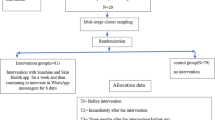Abstract
Although skin cancer is less common in Hispanics, they are at higher risk for presenting with more advanced stage skin cancer. We performed semi-structured interviews with Hispanic women that found high concern for photoaging from sun exposure. Based on these results, we developed two short Spanish-language films. The first emphasized photoaging benefits of sun protection, while the second focused on its benefits for skin cancer prevention. Our hypothesis was that the reduction of photoaging would be a more persuasive argument than skin cancer prevention for the adoption of sunscreen use by Hispanic women. Study participants were recruited from beauty salons located in predominantly Hispanic neighborhoods. Each of the two Spanish-language films was approximately 3 min long. A pre-intervention questionnaire assessed subjects’ general knowledge and sunscreen habits, and a second questionnaire administered after viewing both films assessed for improvements in risk perception and inquired about which film was more persuasive. Eighty Hispanics participated ranging in age from 19 to 75. The pre-education survey found that 54 out of 80 believed that fair-skin Hispanics (FS) were at risk for skin cancer, and 44 out of 80 believed that dark-skin Hispanics (DS) were at risk. These numbers increased to 72 (FS) and 69 (DS) after the intervention (p value: <0.0002 FS, <0.0001 DS). Hispanics overwhelmingly selected the video emphasizing the benefits of sun protection for skin cancer prevention as the more persuasive film (74 out of 80). A Spanish-language video has the potential to make an impact in healthy sun-protective behaviors, and information on how to properly apply sunscreen should be included in educational messages.
Similar content being viewed by others
References
Hispanic or Latino populations. In Minority Health. Centers for Disease Control and Prevention. www.cdc.gov/minorityhealth/populations/REMP/hispanic.html#Disparities. Accessed 3 Jun 2013
Pollitt RA, Clarke CA, Swetter SM, Peng DH, Zadnick J, Cockburn M (2011) The expanding melanoma burden in California Hispanics: importance of socioeconomic distribution subtype and anatomic location. Cancer 117:152–161
We H (1996) Nonmelanoma skin carcinoma in Albuquerque, New Mexico: experience of a major health care provider. Cancer 77:2489–2495
How UV radiation triggers melanoma. NIH research matters. www.nih.gov/researchmatters/february2011/02072011melanoma. Accessed 24 May 2013
Hu S, Parmet Y, Allen G, Parker DF, Ma F, Rouhani P, Kirsner RS (2009) Disparity in melanoma: a trend analysis of melanoma incidence and stage at diagnosis among whites, Hispanics, and blacks in Florida. Arch Dermatol 145:1369–1374
Collins KK, Fields RC, Baptiste D, Liu Y, Moley J, Jeffe DB (2011) Racial differences in survival after surgical treatment for melanoma. Ann Surg Oncol 18:2925–2936
Hu S, Soza-Vento RM, Parker DF, Kirsner RS (2006) Comparison of stage at diagnosis of melanoma among Hispanic, black, and white patients in Miami-Dade County, Florida. Arch Dermatol 146:704–708
Koroukian SM, Bakaki PM, Raghavan D (2011) Survival disparities by Medicaid status: an analysis of 8 cancers. Cancer. doi:10.1002/cncr.27380
Hernandez C, Mermelstein RJ (2009) A conceptual framework for addressing melanoma health disparities research. Arch Dermatol 145(12):1442–1446
Ma F, Collado-Mesa F, Hu S, Kirsner RS (2007) Skin cancer awareness and sun-protection behaviors in white Hispanic and white non-Hispanic high school students in Miami, Florida. Arch Dermatol 143:983–988
Andreeva VA, Unger JB, Yaroch AL, Cockburn MG, Baezconde-Garbanati L, Reynolds KD (2009) Acculturation and sun-safe behaviors among US Latinos: finings from the 2005 Health Information National Trends Survey. Am J Public Health. doi:10.2105/AJPH.2007.122796
Yancey AK, Tanjasiri SP, Klein M, Tunder J (1995) Increased cancer screening behavior in women of color by culturally sensitive video exposure. Prev Med 24:142–148
Frosch DL, Kaplan RM, Felitti V (2001) The evaluation of two methods to facilitate shared decision making for men considering prostate-specific antigen test. J Gen Intern Med 16:391–398
Gimeno-Garcia AZ, Quintero E, Nicolas-Perez D, Parra-Blanco A, Jimenez-Sosa A (2009) Impact of an educational video-based strategy on the behavior process associated with colorectal cancer screening: a randomized controlled study. Cancer Ep 33:216–222
U.S. Census Bureau. http://search.census.gov/search?utf8=%E2%9C%93&affiliate=census&query=pilsen&commit.x=15&commit.y=11. Accessed 19 Jun 2013
Snyder-Ramos SA, Seintsch H, Böttiger BW, Motsch J, Martin E, Bauer M (2005) Patient satisfaction and information gain after the preanesthetic visit: a comparison to face-to-face interview, brochure, and video. Anesth Analg 100(6):1753–1758
Tuong W, Larsen ER, Armstrong AW. Videos to influence: a systematic review of effectiveness of video-based education in modifying health behaviors. J Behav Med. 2012 Nov 28
Sweat M, O’Donnell C, O’Donnell L (2001) Cost-effectiveness of a brief video-based HIV intervention for African American and Latino sexually transmitted disease clinic clients. AIDS 15(6):781–787
Gagliano ME (1988) A literature review on the efficacy of video in patient education. J Med Educ 63(10):785–792
Krouse HJ (2003) Efficacy of video education for patients and caregivers. ORL Head Neck Nurs 21(1):15–20
Sobel RM, Paasche-Orlow MK, Waite KR, Rittner SS, Wilson EA, Wolf MS (2009) Asthma 1-2-3: a low literacy multimedia tool to educate African American adults on asthma. J Community Health 34(4):321–327
Armstrong AW, Idriss NZ, Kim RH (2011) Effects of video-based, online education on behavioral and knowledge outcomes in sunscreen use: a randomized controlled trial. Patient Educ Couns 83(2):273–277
Tucker J, Mueller J (2000) Spouses’ social control of health behaviors: use and effectiveness of specific strategies. Soc Personal Soc Psychol 26:1120–1129
Prochaska JO, DiClemente CC (1982) Transtheoretical therapy: toward a more integrative model of change. Psychother Theory Res Pract 19:276–288
Funding Source
Dr. Hernandez is the recipient of a Dermatology Foundation Women’s Health Career Development Award which partially supported this research. Biostatistical support from the UIC Center for Clinical and Translational Science grant UL1TR000050.
Publishing Disclosure Statement
None of the authors have any financial disclosures in regard to this manuscript.
Author information
Authors and Affiliations
Corresponding author
Rights and permissions
About this article
Cite this article
Hernandez, C., Wang, S., Abraham, I. et al. Evaluation of Educational Videos to Increase Skin Cancer Risk Awareness and Sun-Safe Behaviors Among Adult Hispanics. J Canc Educ 29, 563–569 (2014). https://doi.org/10.1007/s13187-014-0624-z
Published:
Issue Date:
DOI: https://doi.org/10.1007/s13187-014-0624-z



